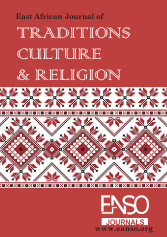Investigating how Art Showcases Cultural Identity in South Western Uganda: A Case Study of Mbarara City
Abstract
Introduction: Art has always been a powerful tool for expressing cultural identity across the world. From the cave paintings of ancient Europe to the contemporary visual and performance art of the 21st century, art serves as a universal language for expressing shared values, beliefs, and experiences. The study explored the role of art in expressing cultural identity in Mbarara City. Methods: This study adopted a cross-sectional research design with quantitative approaches. Data was collected from local artists, cultural institutions and community members. The total sample size was 70 respondents. A stratified random sampling method was used to select the sample, and questionnaires were used in data collection. Descriptive statistics were used to summarise the survey data. Results: It was established that visual arts such as paintings and carvings depict the traditions of the Ankole people and that music and dance are taught to younger generations as part of cultural education. Respondents also noted that folk dances are frequently used during cultural events and festivals. On the role of Art in preservation of culture, it was found out that Art brings people together and promotes unity within communities and that Artists in Mbarara city play a key role in preserving local traditions. Conclusions: The findings show a strong focus on passing cultural traditions (music and dance) to the younger generation, which indicates a positive outlook for the preservation of these aspects of the culture, even though some other traditions (like storytelling and crafts) may be in decline. While there is strong agreement on the importance of music, dance, and visual arts in cultural representation, some traditional elements are less influential in the modern cultural landscape of Mbarara
Downloads
References
Ahmed, H. (2023). "Art and the Human Experience: A Journey of Discovery and Understanding." Journal of Religion and Society 1(1): 50-62.
Al-Zadjali, Z. (2024). "The significance of art in revealing a culture’s identity and multiculturalism." Open Journal of Social Sciences 12(1): 232-250.
Ariffin, W., et al. (2023). "Handicraft innovations: A strategic approach to preserving intangible cultural heritage of Malaysia." ISVS e-journal 10(7): 137-146.
Baral, R. (2023). "Exploring the prominent role of social institutions in society." International Research Journal of MMC (IRJMMC) 4(2): 68-74.
Bhandari, N. B. (2021). "Diaspora and cultural identity: A conceptual review." Journal of Political Science 21: 100-108.
Bhatta, C. (2016). "The role of arts in promoting tourism: A case of tourism development in Thamel area." Journal of Advanced Academic Research 3(1): 177-184.
Echeverri, A. M. (2011). Discovering Cultural Identity: A Journey Interpreted through Artist's Books and Prints, Corcoran College of Art+ Design.
Fischer, H. E., et al. (2023). Quantitative research designs and approaches. Handbook of research on science education, Routledge: 28-59.
Georgios, L. (2018). "The Transformation of Traditional Dance from Its First to Its Second Existence: The Effectiveness of Music-Movement Education and Creative Dance in The Preservation of Our Cultural Heritage." Journal of Education and Training Studies 6(1): 104-112.
Khamalwa, J. P. W. (2024). The Power of Culture and Identity: Imbalu Initiation Ritual Among the Bamasaaba of Uganda, Makerere University Press.
Kidega, S., et al. (2023). "Integrating Ugandan fauna and flora into ceramic art identity." Archives of Current Research International 23: 39-47.
Kigozi, B. (2023). "Citizenship: the role of the performing arts in Uganda." Journal of Visual and Performing Arts 1(1): 29-36.
Mabingo, A. (2019). "‘African dances are valid knowledge’: Dance teachers’ de/construction of meanings from cultural heritage dances in Uganda." Research in Dance Education 20(3): 311-330.
Makwa, D. D. (2016). Collaborative archiving of music and dance: framework for a more-inclusive postcolonial archive among contemporary Bagisu, Uganda, Stellenbosch: Stellenbosch University.
Muyanja, M. (2022). "Art from Home to School: Towards a Critical Art Education Curriculum Framework in Postcolonial and Globalisation Contexts for Primary School Level in Uganda."
Nkiziibweki, A. and E. Mutungi (2018). "Rooted In Culture, Manifested In Contemporary Designs: Developing Bridal Adornments Inspired by Selected Ankole Motifs."
Nsibambi, F. (2022). "Safeguarding Uganda’s Cultural Heritage: An Inquiry into the Opportunities and Challenges Brought by the COVID-19 Pandemic." Advances in Sciences and Humanities 8(1): 22-26.
Onibere, V. and P. O. Ottuh (2024). "Intersection of Art and Religion in African Cultures." Peradaban Journal of Religion and Society 3(2): 100-112.
Pawelski, J. O. (2022). "The positive humanities: Culture and human flourishing." The Oxford handbook of the positive humanities: 17-42.
Qiu, Q., et al. (2022). "Intangible cultural heritage in tourism: Research review and investigation of future agenda." Land 11(1): 139.
Raimo, N., et al. (2022). "Digitalization in the cultural industry: evidence from Italian museums." International Journal of Entrepreneurial Behavior & Research 28(8): 1962-1974.
Salam, S. (2020). Promoting cultural identity through arts education: The Indonesian context. 1st International Conference on Language, Literature, and Arts Education (ICLLAE 2019), Atlantis Press.
Silas-Ufelle, A. and P. Ntagu (2025). "Igbo dress culture and costume." Journal of African History, Culture and Arts 5(1): 46-54.
Song, W. and B. Kim (2019). "Culture and art education to promote cultural welfare in civil society." Social Sciences 8(12): 322.
Ssebulime, A. (2022). A Tale of Continuity of Dance Heritage among the Ugandan Diaspora Community in Trondheim, Norway, NTNU.
Telesetsky, A. (2009). "Culture and development: the role of governments in protecting and promoting culture." Cultural heritage issues: the legacy of conquest, colonization, and commerce. Martinus Nijhoff, Leiden: 335-348.
Uduak, P. and R. W. Akpan (2020). "An overview of the arts as a language of communication, expression and experience: A discourse." Serbian Research Journal of Education, Humanities and Developmental Studies (SRJEHDS, 10 (1), 28–46.
Valerio, E. (2022). "Linguistic and cultural identity: epistemological review." Научный результат. Вопросы теоретической и прикладной лингвистики 8(3): 20-37.
Wanyenya, W. (2013). "The general views of Bamasaba of Eastern Uganda about their oral narratives and cultural songs." International journal of English and literature 4(8): 413-425.
Copyright (c) 2025 Dickson Mwesiga

This work is licensed under a Creative Commons Attribution 4.0 International License.




























